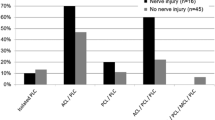Abstract
Purpose
The main purpose of this study was to analyse the incidence of Common Peroneal Nerve Palsy (CPNP) after Total Knee Arthroplasty (TKA) for all alignments. Secondarily, the efficiency and safety of a Peroneal Nerve Release (PNR) prior to TKA in preoperative severe fixed valgus deformities were evaluated to prevent a CPNP.
Methods
Overall, 7612 TKAs were performed in the institution from 2009 to 2021. 1913 TKAs were performed by three surgeons, who consistently performed a PNR in case of a fixed valgus deformity of (1) more than 15°, or (2) more than 10° but in combination with a flexion contracture of more than 15°. Patients with fixed valgus deformities of more than 10° were identified (81 knees) and a comparison was made between the patients who received a PNR (26 knees) and those who did not receive a PNR (55 knees). Data for the analysis were collected from patient medical files and were compared with the Chi2-test or Fisher Exact test.
Results
A CPNP incidence of 0.2% (16/7612) was found after TKA for all alignments together. No CPNP cases (0%) were developed in the PNR-group, compared to five (9%) in the non-PNR group (p = NS). A larger preoperative valgus angle (17° vs 13°, p < 0.001) and flexion contracture (10° vs 3°, p < 0.001) was present in the PNR group compared with the non-PNR group. No PNR-related complications were reported.
Conclusion
The CPNP incidence in this study is consistent with the previous literature. Furthermore, although not significant, the group that received a PNR procedure developed fewer CPNPs compared to the group without PNR.
Level of evidence
Retrospective cohort study, III.
Similar content being viewed by others
Abbreviations
- TKA:
-
Total knee arthroplasty
- OA:
-
Osteoarthritis
- CPN:
-
Common peroneal nerve
- CPNP:
-
Common peroneal nerve palsy
- PNR:
-
Peroneal nerve release
- aFTA:
-
Anatomic femorotibial angle
- AP:
-
Anteroposterior
- ICC:
-
Intraclass correlation coefficient
- EMR:
-
Electronic medical records
- LIA:
-
Local infiltrate analgesia
References
Asp J, Rand J (1990) Peroneal nerve palsy after total knee arthroplasty. Clin Orthop Relat Res 261:233–237
Carender CN, Bedard NA, An Q, Brown TS (2020) Common peroneal nerve injury and recovery after total knee arthroplasty: a systematic review. Arthroplast Today 6:662–667
Christ A, Chiu Y, Joseph A, Westrich G, Lyman S (2019) Incidence and risk factors for peripheral nerve injury after 383,000 total knee arthroplasties using a New York state database (SPARCS). J Arthroplasty 34:2473–2478
Cree A, Coolican M, Tonkin M (1998) Prevention of common peroneal nerve palsy after surgery for valgus deformity about the knee. Knee 5:261–265
Idusuyi O, Morrey B (1996) Peroneal nerve palsy after total knee arthroplasty. assessment of predisposing and prognostic factors*†. J Bone Jt Surg 78:177–184
Koo T, Li M (2016) A guideline of selecting and reporting intraclass correlation coefficients for reliability research. J Chiropr Med 15:155–163
Nercessian O, Ugwonali O, Park S (2005) Peroneal nerve palsy after total knee arthroplasty. J Arthroplasty 20:1068–1073
Park J, Restrepo C, Norton R, Mandel S, Sharkey P, Parvizi J (2013) Common peroneal nerve palsy following total knee arthroplasty: prognostic factors and course of recovery. J Arthroplasty 28:1538–1542
Poage C, Roth C, Scott B (2016) Peroneal nerve palsy: evaluation and management. J Am Acad Orthop Surg 24:1–10
Puijk R, Rassir R, Kok L, Sierevelt I, Nolte P (2021) Common peroneal nerve palsy after TKA in valgus deformities a systematic review. J Exp Orthop 2:2
Rose H, Hood R, Otis J, Ranawat C, Insall J (1982) Peroneal-nerve palsy following total knee arthroplasty. A review of The Hospital for Special Surgery experience. J Bone Jt Surg 64:347–351
Schinsky M, Macaulay W, Parks M, Kiernan H, Nercessian O (2001) Nerve injury after primary total knee arthroplasty. J Arthroplasty 16:1048–1054
Vahedi H, Khlopas A, Szymczuk V, Peterson M, Hammouda A, Conway J (2020) Treatment with posterior capsular release, botulinum toxin injection, hamstring tenotomy, and peroneal nerve decompression improves flexion contracture after total knee arthroplasty: minimum 2-year follow-up. Knee Surg Sports Traumatol Arthrosc 28:2706–2714
Xu J, Liu H, Luo F, Lin Y (2020) Common peroneal nerve “pre-release” in total knee arthroplasty for severe valgus deformities. Knee 27:980–986
Acknowledgements
We thank Marjolein Schager RN, MDiv, for her help with English-language proofreading.
Funding
This research did not receive any specific grant from funding agencies in the public, commercial, or not-for-profit sectors.
Author information
Authors and Affiliations
Contributions
All authors contributed to the conception and design of the study; RP and IS contributed to the acquisition and analysis of data; RP wrote the manuscript; All authors helped draft the manuscript. All authors read and approved the final manuscript.
Corresponding author
Ethics declarations
Conflict of interest
The authors declare that they have no conflict of interest.
Ethical approval
The study was approved by the Institutional Review Board (ACLU# 2021.0026).
Informed consent
No informed consent was needed for this study.
Additional information
Publisher's Note
Springer Nature remains neutral with regard to jurisdictional claims in published maps and institutional affiliations.
Rights and permissions
About this article
Cite this article
Puijk, R., Rassir, R., Kok, L.M. et al. No common peroneal nerve palsies found after a peroneal nerve release prior to TKA in fixed valgus deformities (a retrospective cohort study). Knee Surg Sports Traumatol Arthrosc 30, 4010–4014 (2022). https://doi.org/10.1007/s00167-022-06891-x
Received:
Accepted:
Published:
Issue Date:
DOI: https://doi.org/10.1007/s00167-022-06891-x




